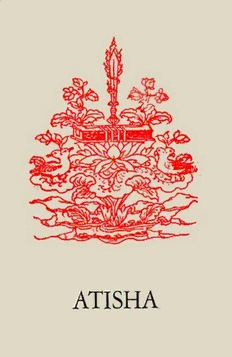Table Of ContentATISHA
Venerable Master Atisha
Dipamkara Srijnana
ATISHA
A biography of the renowned Buddhist sage
Translated from Tibetan sources
by
LAMA THUBTEN KALSANG et al
The Social Science Association Press
Bangkok 1974
MAHAYANA PUBLICATIONS
First published in 1974
The Social Science Association Press of Thailand
Bangkok
Reprinted in 1983
Second reprint, 1984
MAHAYANA PUBLICATIONS
5/5, Shantiniketan
New Delhi 110021
India
ISBN 0 86171 015 0
Cover design by Greg Moscatt
Illustration of Atisha page ii by Anila Jampa Choedron
Printed at
Jndraprastha Press (C.B.T.),
Nehru House, New Delhi-11 0002
CONTENTS
Foreword vii
Translators' Preface ix
Preface to the Second Printing xi
The Biography of Atisha 3
Atisha's Journey to Suvamadvipa 31
Atisha and the Restoration of Buddhism in Tibet 47
Editor's Note:
Diacritics should be used in several Sanskrit and Tibetan
words to convey exact pronunciation. They have not been used
in this printing due to the unavailability of the type cast.
FOREWORD
I wish to offer my congratulations and express my appreciation
and pleasure to the Tibetan Bhikshus, Thubten Kalsang and Ngo
drub Paljor, together with Mr. John Blofeld of Great Britain, all
residents of Thailand, for preparing and publishing this abridged
translation into English of the life and deeds of the incomparable
Great Master Atisha.
The great being known as the Venerable Master Atisha, Dipam
kara Srijnana, was born in Bengal, East India, in the second half
of the tenth century. From a very young age, he studied myriads
of scriptural texts on various subjects in harmony with his per
sonal practice. He became a great master-practitioner famous
throughout India.
In coming to Tibet in the eleventh century, Atisha eliminated ·an
mistakes there from misunderstandings and lack of understanding
concerning the textual and oral teachings of Hinayana and Maha
yana as well as Tantrayana. By illuminating the path of how to
practise all the teachings of the Buddha without any contradic
tion, he has been extremely kind, especially to the Tibetans of
the Land of the Snow.
Therefore, I offer my prayers and hopes that this publication
into English of the life and deeds of the Venerable Atisha will be
of vast benefit to many fortunate beings.
GEJONG TENZIN GYA TSO
The XIV Dalai Lama
September 10, 1973
TRANSLATORS' PREFACE
This volume consists of a complete translation from the Tibetan
of "The Biography of Atisha" by Gurugana Dharmakaranama,
together with extracts from "The Spread of Buddhism in Tibet"
compiled by the Tibetan Teachers' Training College at Dharam
sala, India, which have been added to make the story complete
by giving an account of Atisha's visit to Tibet.
Atisha, an Indian monk of royal birth, who was born in 980
A.D., entered Tibet in the year 1038 and died near Lhasa in 1052
A.D. The author of a great number of learned works and founder
of the Kadampa sect from which the present-day Gelugpa sect is
derived, he is so profoundly reverenced for his wisdom that Tibe
tans regard him as an incarnation of Manjushri Bodhisattva.
Above all he is honoured for purifying Tibetan Buddhism of
certain doubtful tendencies and restoring the great Mahayana
doctrine in its pristine purity.
Part of the charm and interest of this book lies in its being an
authentic example of Tibetan historical writings. The reverential
approach tends to poetic truth rather than to historical accuracy,
but it would be wrong to treat the more fabulous incidents as
having no foundation in fact. For example, the picturesque pass
age in which Atisha's companion, Bhumisara, is depicted as des
troying the palace of a heretical goddess and gravely injuring
Maheshvara, King of Heretics, besides obliterating the black tent
of the Bonpo King of the Shangshung by hurling thunderbolts
upon them from the ocean where his ship was becalmed, is not
X
intended to be taken literally, but to represent the prowess of
Atisha and his companions in rooting out false teachings that
obscured the light of the Dharma. For the rest, the book contains
many passages of great beauty, some edifying discourses in the
Dharma and some delightful poetry of which much of the excel
lence has been lost in the process of translation.
The method used to render the work into English resembles, in
a very humble way, that of the great translators who translated
the Mahayana Canon from Sanskrit into Tibetan. That is to say,
it .is the work of a team consisting of people with different sets
of qualifications. One of. us has a scholarly knowledge of Tibetan
and a fair command of English; another is an English writer with
a knowledge of Buddhism and some acquaintance with the Tibetan
background; the third possesses an adequate knowledge of both
languages. First a very literal translation was made, then the
English was refined, after which the resulting text was compared
very carefull)\ with the original and all the obvious errors elimi
nated. Our purpose has been to make the English rendering as
faithful as possible to the Tibetan within the limits imposed by the
very different nature of the two languages. Here and there, the
order of words has been changed slightly to accord with the
demands of English style and syntax, but changes of this sort
have been kept to a bare minimum.
We have undertaken this work to pay honor to a great Bud
dhist sage whose work bas been of incalculable benefit to the
Tibetan people. We are very conscious of our own shortcomings
and crave forgiveness for whatever errors and inadequacies there
may be. May the Buddha Dharma flourish and may the name of
the great Atisha be long remembered in this world!
Bangkok, summer 1973

